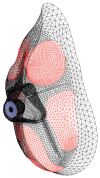The OxyMask(™) development and performance in healthy volunteers
- PMID: 22915909
- PMCID: PMC3417856
The OxyMask(™) development and performance in healthy volunteers
Abstract
Background: The OxyMask(™) is a unique, open-style, oxygen mask that was originally developed in 2005. The original mask was modified, using computational fluid dynamics numerical simulations, with the goal of allowing it to produce a wider range of FiO(2). This analysis was used to guide the modification of the mask shell and the location for the oxygen diffuser.
Methods: The new OxyMask was attached to 10 healthy subjects and used to deliver escalating levels of oxygen (1.5, 2, 2.5, 3, 5, 10, 15, 20, 25 and 30 LPM) for 90 seconds at each level and the resulting FiO(2) was recorded (at the lips) from 5 consecutive measurements at each oxygen flow rate.
Results: Mean FiO(2) was 25.4% at 1.5 LPM of oxygen, 30.1% at 2 LPM, 36.5% at 2.5 LPM, 41.8% at 3 LPM, 57.6% at 5 LPM, 74.4% at 10 LPM, and 80.1% at 15 LPM. Each FiO(2) achieved at these escalating oxygen levels was significantly greater than all the previous levels. The mean FiO(2) was 82.8 at 20 LPM, 84.2% at 25 LPM and 84.3% at 30 LPM. All of these values on average were not significantly greater than the FiO(2) achieved with 15 LPM. In a few subjects a maximum FiO(2) of 90% was reached.
Conclusion: The original OxyMask was successfully modified so that the second generation of the mask can provide a wide range of FiO(2), from 25% to 90%, while keeping its unique open design.
Keywords: OxyArm™; OxyMask™; biomedical engineering; clinical trial; computational fluid dynamics (CFD); equipment design; oxygen; oxygen masks; oxygen therapy.
Figures






Similar articles
-
Comparison of the OxyMask and Venturi mask in the delivery of supplemental oxygen: pilot study in oxygen-dependent patients.Can Respir J. 2006 Jul-Aug;13(5):247-52. doi: 10.1155/2006/720320. Can Respir J. 2006. PMID: 16896425 Free PMC article. Clinical Trial.
-
Superiority of OxyMaskTM with less carbon dioxide rebreathing in children.Eur J Pediatr. 2021 Dec;180(12):3593-3597. doi: 10.1007/s00431-021-04157-1. Epub 2021 Jun 19. Eur J Pediatr. 2021. PMID: 34146139
-
Oropharyngeal Oxygen Concentration Is Dependent on the Oxygen Mask System and Sampling Location.Respir Care. 2020 Jan;65(1):29-35. doi: 10.4187/respcare.07027. Epub 2019 Sep 10. Respir Care. 2020. PMID: 31506337 Clinical Trial.
-
Evaluation of i-gel(™) airway in children: a meta-analysis.Paediatr Anaesth. 2014 Oct;24(10):1072-9. doi: 10.1111/pan.12483. Epub 2014 Jul 16. Paediatr Anaesth. 2014. PMID: 25041224 Review.
-
Effects of increased oxygen breathing in a volume controlled hemorrhagic shock outcome model in rats.Resuscitation. 2000 Aug 1;45(3):209-20. doi: 10.1016/s0300-9572(00)00183-0. Resuscitation. 2000. PMID: 10959021 Review.
Cited by
-
Investigating the Effects of Protective Face Masks on the Respiratory Parameters of Children in the Postanesthesia Care Unit During the COVID-19 Pandemic.J Perianesth Nurs. 2022 Feb;37(1):94-99. doi: 10.1016/j.jopan.2021.02.004. Epub 2021 Feb 11. J Perianesth Nurs. 2022. PMID: 34824000 Free PMC article. Clinical Trial.
-
Peripapillary Vascular Reactivity in Primary Open-Angle Glaucoma With High Myopia by Using Optical Coherence Tomography Angiography.Front Med (Lausanne). 2022 Mar 18;9:850483. doi: 10.3389/fmed.2022.850483. eCollection 2022. Front Med (Lausanne). 2022. PMID: 35372433 Free PMC article.
-
Medicolegal aspect of loss of smell and olfactory event-related potentials.Egypt J Forensic Sci. 2022;12(1):47. doi: 10.1186/s41935-022-00306-1. Epub 2022 Oct 27. Egypt J Forensic Sci. 2022. PMID: 36320625 Free PMC article.
-
OxyMask is not superior to a non-rebreathing oxygen mask for oxygen supply in a post-anesthesia care unit in Korea: a comparative study.Ewha Med J. 2024 Apr;47(2):e26. doi: 10.12771/emj.2024.e26. Epub 2024 Apr 30. Ewha Med J. 2024. PMID: 40703693 Free PMC article.
-
Southmedic OxyMask(TM) compared with the Hudson RCI(®) Non-Rebreather Mask(TM): Safety and performance comparison.Can J Respir Ther. 2016 Winter;52(1):13-5. Can J Respir Ther. 2016. PMID: 26909009 Free PMC article.
References
-
- Leigh JM, Leigh JM. The evolution of oxygen therapy apparatus. Anaesthesia. 1974;29:462–485. - PubMed
-
- Blodgett AN. The continous inhalation of oxygen in cases of pneumonia otherwise fatal, and in other diseases. Boston Med Surg J. 1890:481–484.
-
- Leigh JM. Oxygen therapy techniques after 200 years. A survey of present practice and current trends. Anaesthesia. 1973;28:164–169. - PubMed
LinkOut - more resources
Full Text Sources
Medical
Miscellaneous
